Building a successful product demands more than great ideas; it requires clarity, teamwork, and the ability to adapt quickly when priorities shift. Yet most teams struggle with scattered plans, missed deadlines, and confusion about what comes next.
The answer? A flexible, AI-powered product roadmap that connects strategy to execution and keeps everyone moving in sync.
In this guide, you’ll discover how smart product teams use dynamic roadmap tools like monday dev to turn uncertainty into confidence by planning smarter, aligning stakeholders, and delivering results faster.
Try monday devKey takeaways
- A flexible, AI-powered product roadmap connects strategy to execution, driving clarity and teamwork while adapting quickly to changes.
- Product roadmaps centralize goals, features, timelines, and milestones, helping all teams align and make informed decisions throughout the development cycle.
- Successful roadmaps feature collaborative planning, real-time visibility, and tailored formats for different stakeholders, including internal, technical, and customer-facing audiences.
- Choosing the right roadmap tool unlocks seamless integration, user-friendly workflows, and ongoing alignment for improved product delivery and business outcomes.
- Built on monday.com Work OS, monday dev empowers teams with hierarchy board views, advanced AI automations, and customizable dashboards for smarter, faster roadmap management.
What is a product roadmap?
A product roadmap is a high-level action plan that outlines the necessary steps to achieve your long-term vision and business objectives. Your product roadmap should outline the vision, direction, and product goals, together with a high-level overview of your planned features, milestones, and deadlines.
Product roadmaps provide product teams with a centralized, shared location for all high-level information related to the product, ensuring both development teams and sales teams are on the same page.
The product manager or product team owns the product roadmap; however, successful roadmaps require cross-functional input and ongoing collaboration with engineering, leadership, and other stakeholders.
What are the benefits of a product roadmap?
A product roadmap provides strategic clarity, cross-team alignment, and accelerated delivery for organizations aiming to develop successful products. By visualizing priorities, tracking milestones, and communicating changes, roadmaps become a single source of truth that drives informed decision-making from product strategy to execution.
- Unified vision and alignment: Roadmaps ensure every stakeholder — from product and engineering to marketing and leadership — is organized around shared goals, reducing confusion and miscommunication.
- Prioritization and transparency: Team members can easily see which features or projects matter most, streamlining efforts and communicating shifts in priorities as needed.
- Accelerated execution: Modern tools like monday dev leverage AI and automations, speeding up planning, surfacing risks early, and helping teams deliver features and updates faster.
- Real-time reporting and visibility: Dashboards, milestone tracking, and progress analytics keep everyone informed and accountable, empowering organizations to course-correct with confidence.
- Risk management: Roadmaps help teams identify potential roadblocks and resource constraints before they impact delivery, enabling proactive problem-solving and effective resource allocation.
By centralizing strategy, communication, and measurement, a product roadmap provides organizations with the tools and clarity to achieve business targets — making product delivery smarter, smoother, and quicker.

"monday dev empowered us to optimize our GTM approach, resulting in faster, more dependable deliveries"
Steven Hamrell | Director of Product Management
"monday dev empowers us to manage the entire development process on one platform so we can speed up product delivery and improve customer satisfaction"
Mitchel Hudson | Head of Technology
"We're operating in an open, deep trusting, transparent environment with no silos of information. It's about completely opening access to everyone who needs it."
Alan Schmoll | Executive Vice President, Vistra PlatformWho owns a product roadmap?
A product roadmap is most often owned by the product manager or the product team, because they’re responsible for turning product strategy into an actionable plan. However, effective ownership means orchestrating input across departments. Here’s what that looks like:
- Product management sets the vision, priorities, and goals that guide the roadmap
- Engineering provides feasibility input, identifies technical dependencies, and estimates timelines
- Leadership/Executives ensure alignment with business strategy, resources, and long-term objectives
- Marketing and sales surface customer feedback, competitive insights, and go-to-market considerations.
- Customer success/support share insights from real users and highlight feature gaps or opportunities.
The roadmap works best when the product manager acts as the curator of cross-functional perspectives, making sure all voices are heard while keeping decisions aligned with strategic goals.
Why a roadmap is critical for alignment
Acting as a single source of truth, a product roadmap connects strategic goals, ongoing work, and team priorities across an organization. With a well-defined and dynamic roadmap, everyone gains alignment through:
- Shared strategic vision: Roadmaps clarify the product direction, so all teams work toward the same goals, reducing miscommunication and duplicated effort.
- Cross-functional visibility: A centralized roadmap gives every department access to up-to-date plans, dependencies, and changes, ensuring stakeholders are always on the same page.
- Clear accountability: Alignment occurs naturally when roles, milestones, and responsibilities are clearly defined, fostering open feedback and proactive problem-solving.
In short, a roadmap brings clarity, visibility, and direction — making coordinated execution possible.
5 types of product roadmaps for every use case
It’s important to define your audience when creating your roadmap, which is why different types of roadmaps come into play depending on the audience and goals.
Here are some of the common types of product roadmaps:
1. Strategic roadmap
Purpose: Highlights the value of a product, and the steps that will drive the product to success through product objectives, milestones, and initiatives. It generally doesn’t focus on more granular timeline details, unlike other roadmaps.
Audience: Internal teams including stakeholders, execs, and developers, so that they can align on high-level product plans.
2. Features roadmap
Purpose: To focus on specific product features and how/ when they will be developed.
Audience: Development, product, and engineering teams to align on the steps and timeline needed to deliver specific features.
3. Release date roadmap
Purpose: To outline a product’s planned release dates so internal teams can stay aligned on the product’s development.
Audience: Marketing, sales teams, product development, and any other internal team that needs to know about release dates to structure their respective plans.
4. Developmental roadmap
Purpose: For technical teams to dive into the specifics of product implementations, breaking things down through epics, themes, milestones, and sprints.
Audience: Development teams, as it’s highly technical and will likely only make sense to those working on the product’s development.
5. External roadmap
Purpose: To highlight the value and benefits of a product so customers and prospective customers can anticipate what to expect.
Audience: The public. Potential investors, customers, or anyone who may take an interest in the product.
For an example of an external roadmap, take a look at the monday.com product roadmap video shared with our customers:
Most organizations often blend multiple roadmap types, customizing details and views for different audiences so that every stakeholder stays aligned, and planning moves as fast as the market demands. For example, a product manager might share a release roadmap with engineering, a strategic roadmap with leadership, and an external roadmap with customers — all generated from the same workspace.
How to choose the right product roadmap tool
Choosing the right product roadmap tool depends on team needs, flexibility, integration options, and the ability to support multiple stakeholders and work styles.
The best tool should enable real-time updates, collaborative planning, and customizable views, while minimizing admin overhead and allowing seamless alignment across departments.
Here are some tips for how to choose the right software:
- Assess team requirements: Identify the methodologies your teams use (Agile, Waterfall, or hybrid), preferred views (timeline, Kanban, Gantt), and the level of collaboration needed across product, engineering, and business units.
- Evaluate integration and automation: Choose a platform that easily connects with your existing tools (e.g., GitHub, Slack) and supports workflow automations, reducing manual work and keeping data in sync.
- Look for real-time visibility: Opt for a tool with built-in reporting, dashboards, and AI features that highlight progress, risks, and resource allocation, allowing for faster, data-driven decisions.
- Prioritize user experience: Select a tool with an intuitive, no-code interface that allows anyone to contribute without lengthy training, ensuring quick and painless onboarding.
- Support for multiple audiences: Ensure the tool can share tailored views and permissions with executives, dev teams, and customers, making alignment easy regardless of technical expertise.
- Compare pricing and support: Review the total cost of ownership for licenses, integrations, and support, preferably with transparent, all-in-one pricing rather than fragmented subscriptions.
With roadmap software like monday dev, you get all the elements for product teams to plan, adapt, and deliver at scale — keeping everyone aligned and workflows streamlined.
Try monday devHow to create a product roadmap in 5 steps
Follow these 5 essential steps to create your product roadmap.
Step 1: Define your product strategy and high-level goals
The first step, to define the “why” behind your product, is arguably the most important. It’s the foundation that holds up your entire product and strategy that will propel it to success.
This high-level understanding of your product should encompass why you’re creating it, who your customers are, what makes your product unique, and how it will perform in the market, supported by relevant statistics and research. Think: What are your specific, measurable goals and objectives that will bring your product vision to life?
Step 2: Capture and prioritize product features
The next step is to take all this preliminary information and dig deeper into the specific product features. Focus on market research, feedback from current or prospective customers, and stakeholder input to plan out the features you will focus on.
Then, prioritize features by importance. You can take from a few different prioritization frameworks, including the MoSCoW method.
Pro tip: The acronym MoSCoW stands for must have, should have, could have, and won’t have.
Step 3: Organize and schedule roadmap items into releases
Next, you’ll need to address the “when.” Select your timeframe, whether it’s months, days, quarters, or any other period that works best for your team. After considering project dependencies and resource allocation, you’ll then map out when each feature can be released. This step also involves specifying and integrating tasks that must be completed for each time phase.
Step 4: Visualize and share the roadmap with stakeholders
A product roadmap is essentially useless if nobody can properly understand it. The information should be presented in the most intuitive way possible for its audience, potentially extending beyond a traditional roadmap document. Here’s where roadmap views come in.
There are different ways to visualize your roadmap, including a timeline view, Gantt view, Kanban view, and more. One effective way to visualize is through a dedicated roadmap tool.
Step 5: Track progress, gather feedback, and refine your roadmap
Regularly monitor your roadmap, using dashboards and analytics to evaluate progress against your goals. Invite feedback from engineering, business, and other stakeholders, and update the roadmap as priorities shift or new insights emerge. Tools like monday dev make it easy to automate updates, collect input, and keep everyone aligned in real time.
What should a product roadmap include?
A comprehensive product roadmap should clearly communicate strategy, priorities, and progress, while also enabling collaboration and adaptability across teams.
Vision and objectives: Outline your product’s strategic goals and rationale, offering context and direction for every stakeholder.
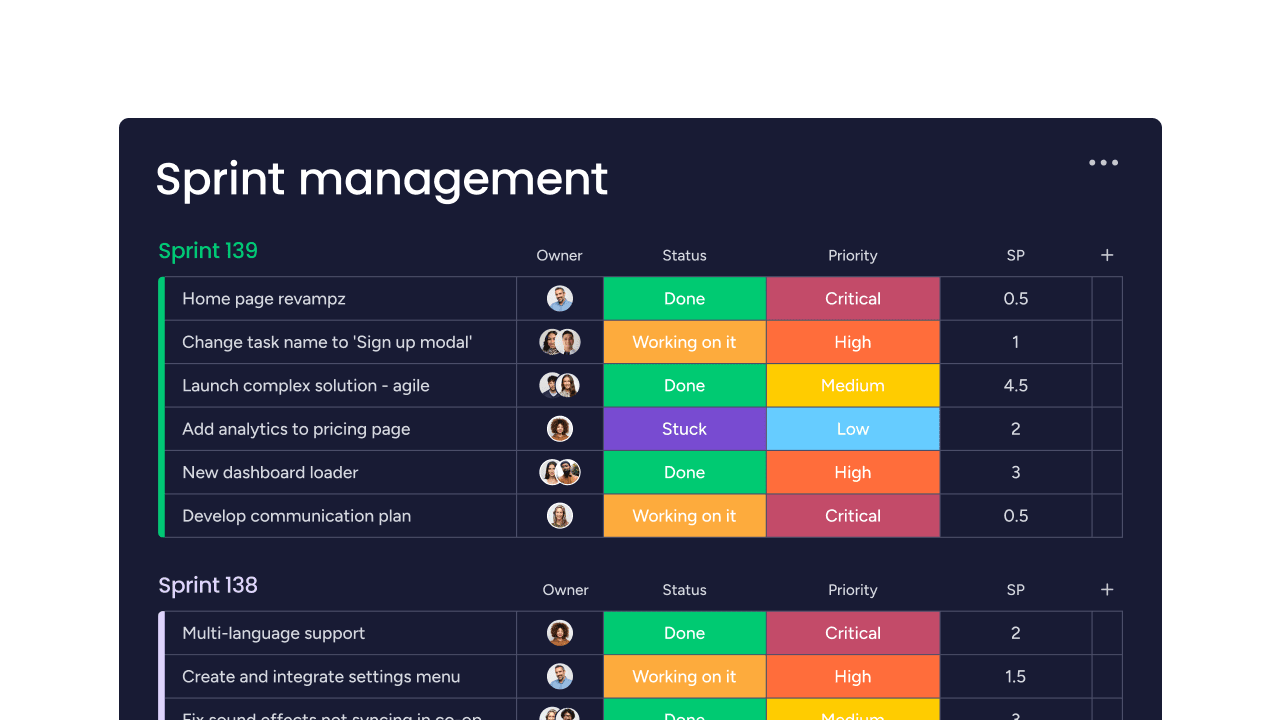
Prioritized features and initiatives: List the major features or enhancements, organized by business impact, customer needs, market trends, and stakeholder feedback.
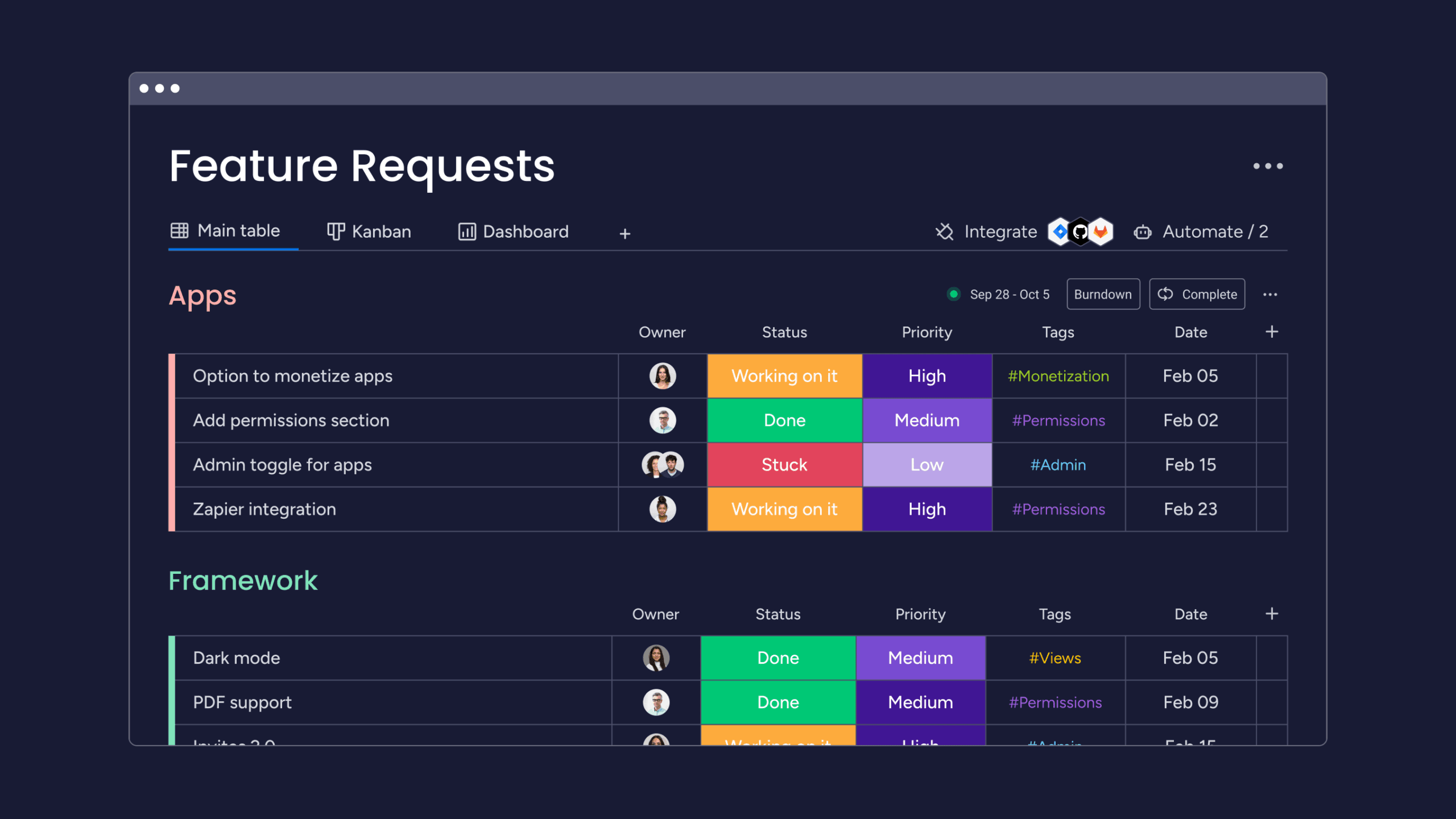
Release plan and timelines: Use timeline, calendar, or Gantt views to map out planned releases. Show dependencies between items for realistic planning.
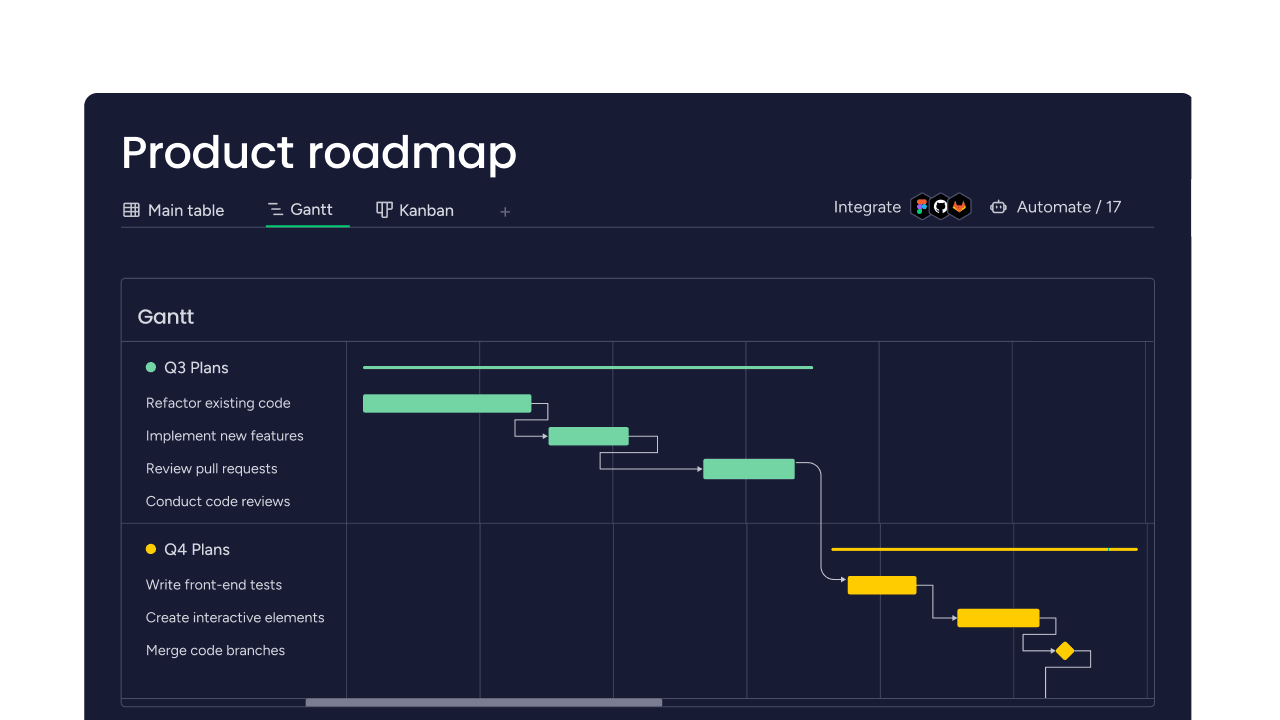
Resource allocation: Specify the required headcount, budget, skills, and time needed to achieve roadmap milestones, helping teams understand constraints and plan effectively.
Analytics and metrics: Define success criteria and KPIs to track goal achievement, adoption, or delivery so that progress is always visible and measurable.
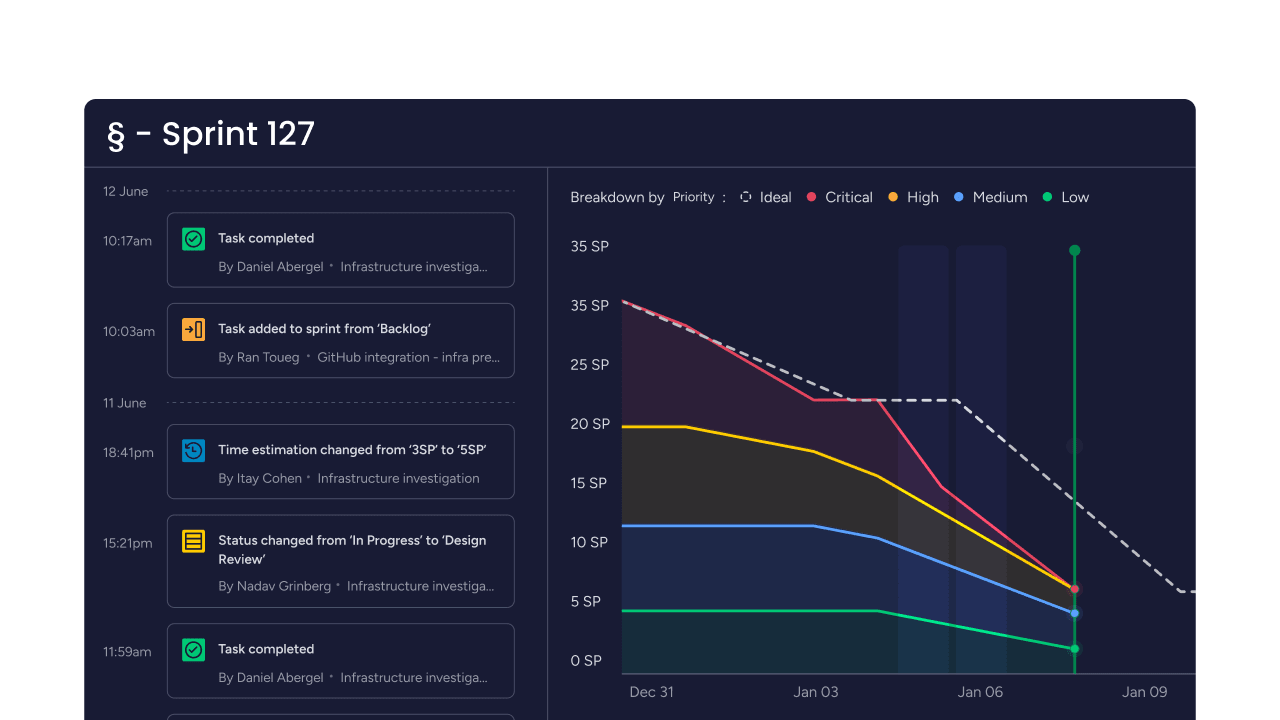
What should an Agile product roadmap include?
If you’re using the Agile approach instead of traditional Waterfall planning, your roadmap may look slightly different. Some teams prefer Agile because it involves rapid iteration, which makes it easier to adjust plans in line with customer requirements.
A typical Agile product roadmap includes the following elements:
- Themes: Define the overall “themes” that you’re working on as a company — major goals or strategic areas that guide overall product direction and track long-term vision.
- Initiatives: Key workstreams or large user stories grouped by theme and plotted along a timeline.
- Epics: Collections of “stories” (end-user requests or deliverables) grouped to form a short-term goal within the wider initiative.
- Sprints or release cycles: Short, time-boxed periods (e.g., 2-week sprints or quarterly releases) that break down epics into actionable work, supporting regular delivery and learning.
- Stories and tasks: Specific user stories and development tasks prioritized within each sprint, reflecting evolving customer needs and team feedback via feature requests.
- Dependencies and risks: Clearly mapped cross-team dependencies and blockers so teams can address obstacles early.
- Metrics and KPIs: Criteria for success and analytics — such as sprint velocity, release adoption, or customer satisfaction — to track progress and guide iterative improvement.
- Ownership: Identify accountable teams or owners for themes, initiatives, and releases to support transparency and informed decision-making.
Future-proof Agile roadmap software, like monday dev, also leverages automations and AI to keep sprints on track, surface risks, and make prioritization easier — keeping planning proactive and customer-focused.
Whether you’re using an Agile approach or not, monday dev lets your team design the roadmap you need, and then seamlessly manage your development cycle and product development process with one easy-to-use platform.
Try monday devmonday dev Testimonials

"monday dev empowered us to optimize our GTM approach, resulting in faster, more dependable deliveries"
Steven Hamrell | Director of Product Management
"monday dev empowers us to manage the entire development process on one platform so we can speed up product delivery and improve customer satisfaction"
Mitchel Hudson | Head of Technology
"We're operating in an open, deep trusting, transparent environment with no silos of information. It's about completely opening access to everyone who needs it."
Alan Schmoll | Executive Vice President, Vistra PlatformHow to structure a product roadmap to reach product goals
The 3 main ways to structure a roadmap are to base it on themes, product lines, or timelines.
1. By themes
The first option is to structure your roadmap based on high-level themes. This is common for Agile teams and is easy to implement because the logical order is self-explanatory.
Theme > epic > user story
Common Agile themes include user experience enhancement, performance optimization, new feature development, and market expansion, among others.
Say your theme is user experience enhancement. Your epic should then make this theme actionable and include points like simplifying the onboarding process, improving navigation, and enhancing the mobile experience.
Then, the user story needs to respond to the requests brought up in epics with specific plans or features. In this scenario, for the point brought about by simplifying the onboarding process, a user story could be to reduce the number of steps required for a new user to sign up from 7 to 3.
2. By product
If you focus on multiple products in a single roadmap, that’s technically a program roadmap or portfolio roadmap. You can use it separately from, or in combination with, single-product roadmaps.
To structure your roadmap using your product lines, add the products as top-level categories. For each product, add the groups of features you’ll be working on. Finally, break down each feature group into individual features.
A multi-product roadmap is useful when allocating resources between different projects.
3. By time
You can also create a roadmap by mapping out a timeline in quarters (or any other preferred unit of time). Instead of the initial grouping being themes, it’s purely time-based. From there, you can include larger epics or even features directly, depending on your timeframe.
How monday dev enables flexible product roadmap planning
Built on monday.com WorkOS, monday dev equips product teams with everything needed for flexible planning and fast, high-impact delivery. Start quickly using dedicated templates, then tailor your roadmap with visual timeline, Kanban, or Gantt views. Plus, leep stakeholders aligned through permissioned dashboards, comments, and instant updates. Let’s look at some key monday dev features.
Hierarchy board view: Connect strategic goals to epics, sprints, and tasks in one workspace.
Hybrid methodologies: Switch or combine Agile, Waterfall, and custom planning (e.g., Scrum, Kanban, or Scrumban) as your team needs.
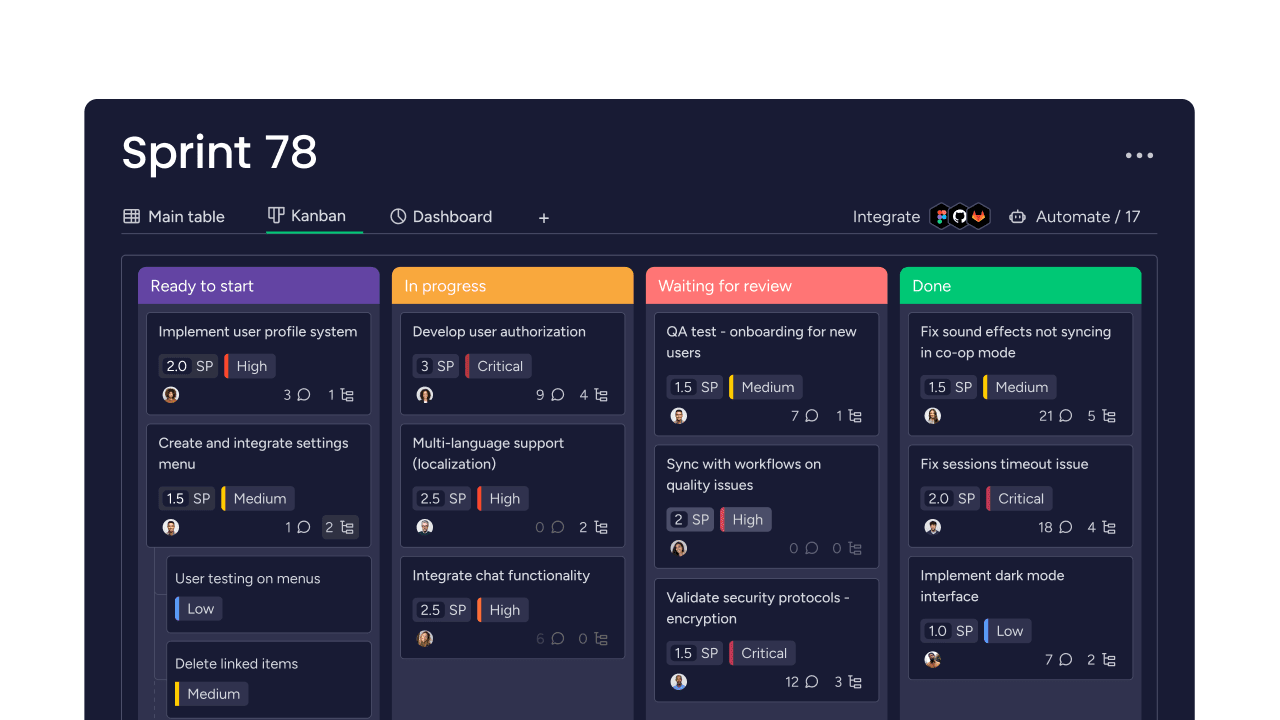
AI-powered planning: Get smart suggestions, proactive risk detection, and dynamic resource optimization.

Seamless integrations: Sync workflows across developer tools, communication platforms, and more.
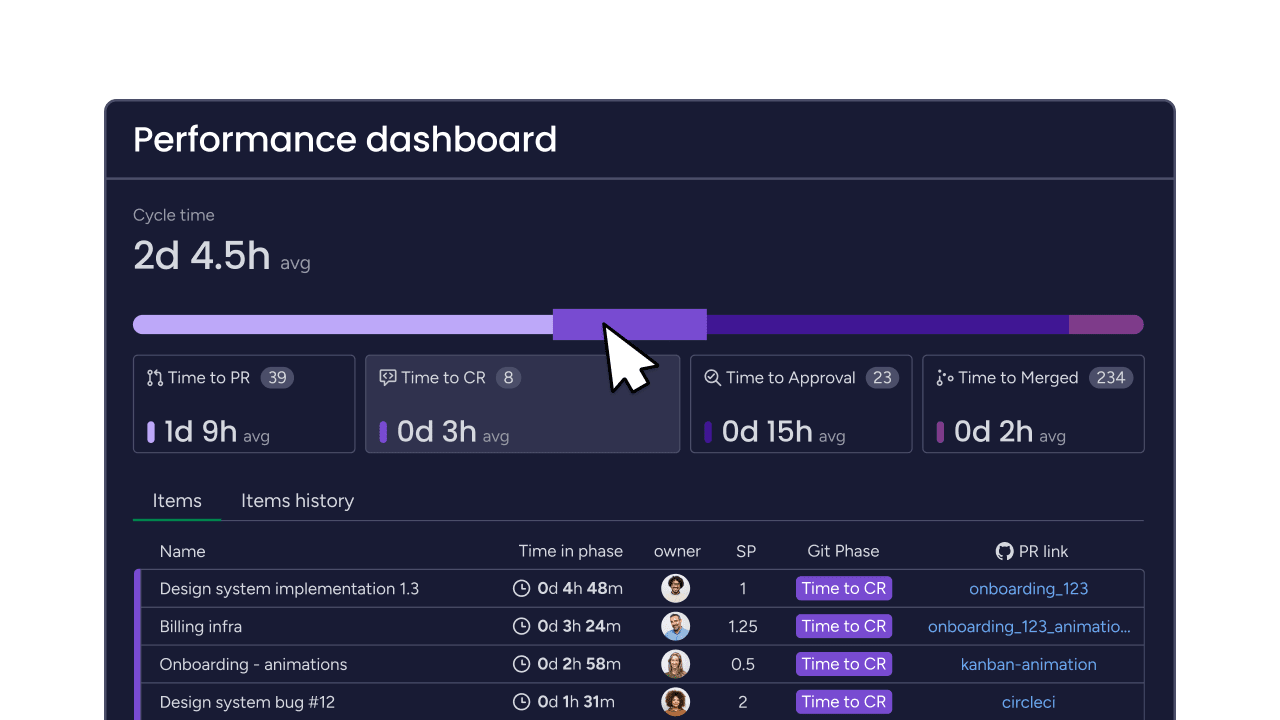
Customizable templates: Start quickly with ready-made templates for roadmaps, sprints, release plans, and backlog management.
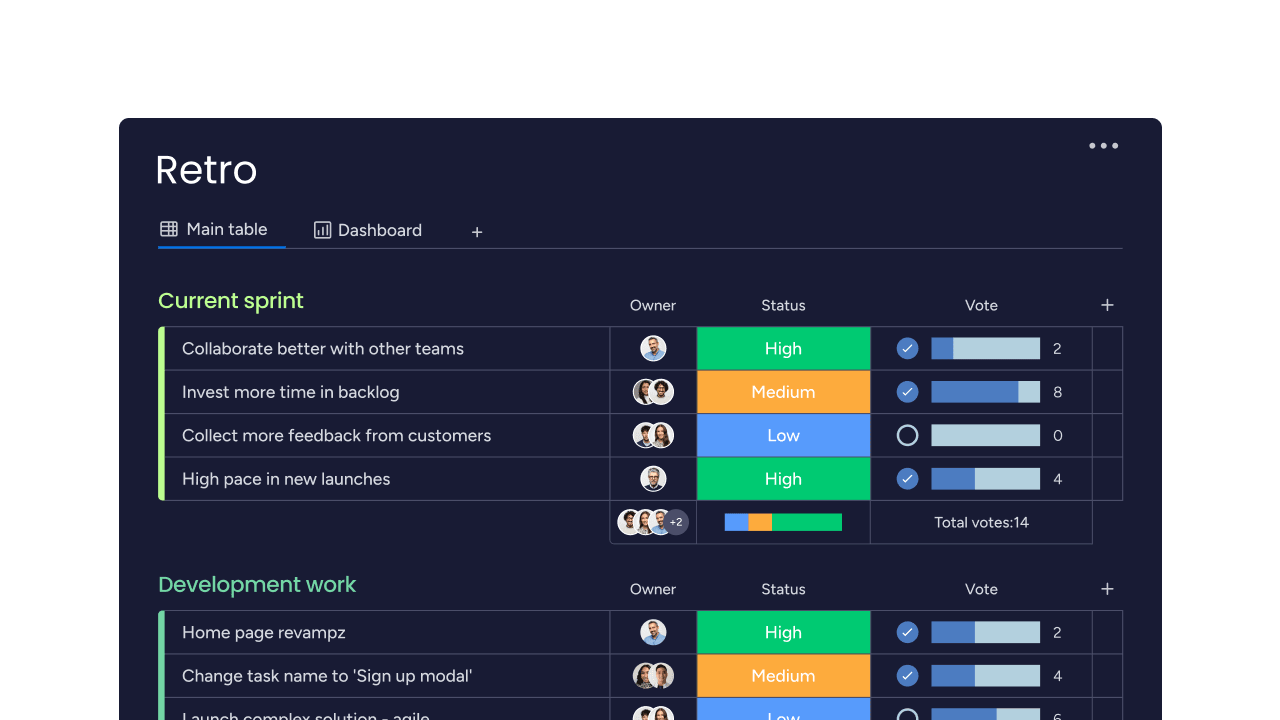
Real-time dashboards and analytics: Track KPIs, progress, and velocity for continuous improvement.
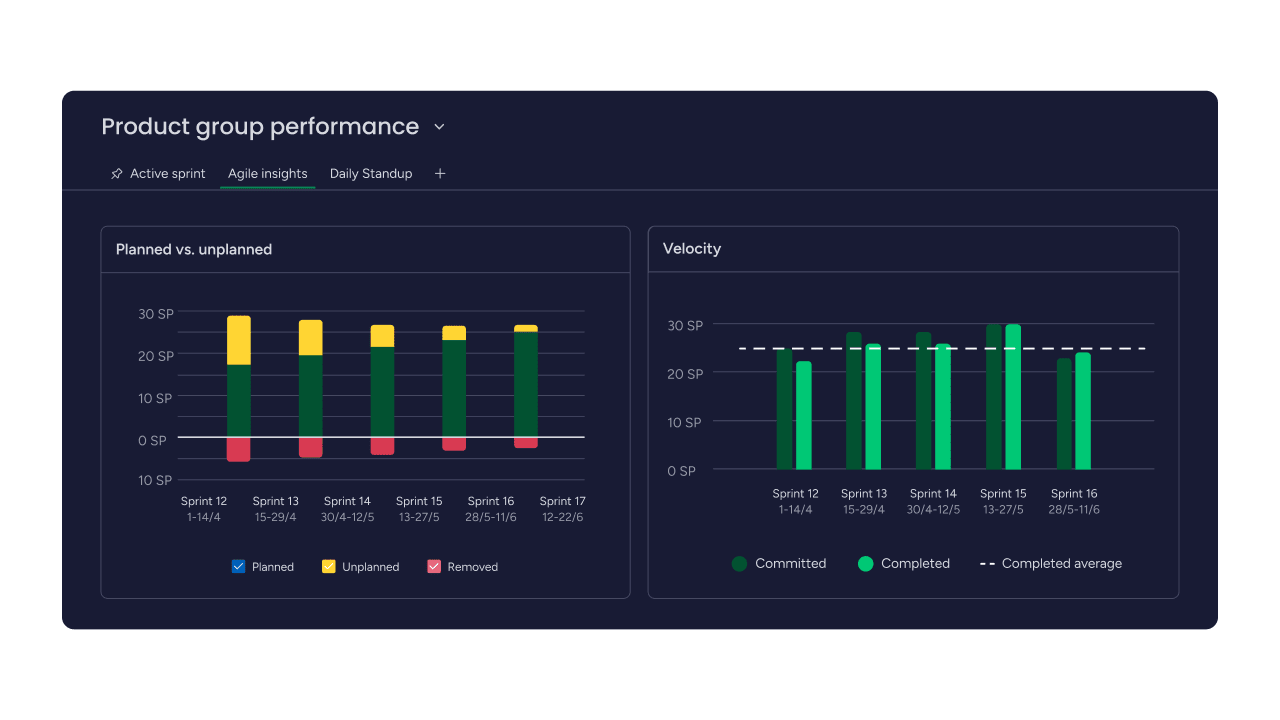
With fast onboarding, integrated feedback tools, and powerful automation, monday dev helps teams deliver better products, stay aligned, and respond quickly to change — making product roadmap management smarter and easier, every step of the way.
Bring your product roadmap to life
Building a product roadmap is about more than timelines and features. You have to create a living plan that adapts as your business and customers evolve. The right tool helps you connect strategy to execution, align stakeholders, and respond to change without losing focus.
With monday dev, you can design flexible, AI-powered roadmaps that keep your team in sync and your product moving forward. From strategy to sprints, everything you need to plan, adapt, and deliver lives in one place.
Try monday devFAQs
What's the difference between an internal and an external roadmap?
An internal roadmap is intended for cross-functional teams to guide product development, prioritize work, and track progress. An external roadmap (also known as a customer-facing roadmap) shares planned releases and high-level features with customers or partners, focusing on benefits and timelines while omitting confidential details.
What’s the difference between a product strategy and a product roadmap?
A product strategy defines long-term vision, goals, and market positioning—why and what the product aims to achieve. A product roadmap translates this strategy into an actionable plan, mapping out features, priorities, and timelines to deliver on strategic goals.
What’s the difference between an IT roadmap and a product roadmap?
An IT roadmap outlines upgrades, infrastructure changes, and software deployments to support business operations. A product roadmap focuses on developing, improving, and delivering product features for end users. They address different audiences and goals, but may overlap for tech-driven products.
How does a product roadmap differ from a product backlog?
A product roadmap provides a high-level overview of upcoming features, releases, and milestones aligned with business goals. A product backlog is an evolving, detailed list of technical tasks, user stories, and fixes to be prioritized and worked on during sprints or development cycles.
Can I create different roadmap views for different stakeholders?
Yes, modern tools like monday dev allow you to build customizable roadmap views and set permissions, ensuring each stakeholder — executives, developers, or customers — sees the most relevant information. Tailored views improve clarity and alignment across the organization.
How does a flexible product roadmap tool compare to using Jira or spreadsheets?
Using a flexible product roadmap tool, such as monday dev, enables all teams to benefit from no-code customization, intuitive dashboards, and real-time collaboration. While Jira and spreadsheets require manual updates and complex configurations, monday dev automates workflows, integrates data, and supports multiple planning methodologies easily.
How do I connect high-level roadmap goals to dev team sprint tasks?
Link roadmap objectives to sprint backlogs by mapping epics and features directly to user stories and tasks. Using monday dev makes this seamless with hierarchy views and integrated boards, giving visibility from strategic goals down to day-to-day execution and progress tracking.
 Try monday dev
Try monday dev



